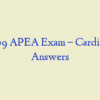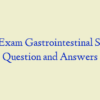Description
APEA Exam Question and Answers – NEUROLOGY
- The level of consciousness that refers to the ability of the patient to respond fully and appropriately to stimuli is known as:
- When assessing the patient’s sense of position, instruct the patient to first stand with his feet together and eyes open, then instruct him to close both eye for 30-60 seconds. If he loses his balance with his eyes closed, this is:
- When comparing two sides of the body for symmetric sensation a symmetrical distal sensory loss would be suggestive of:
- A female patient complains of weakness in her arm when combing her hair. This finding could be suggestive of which type of weakness pattern?
- Having the patient shrug his shoulders and elicit neck movements would be testing cranial nerve:
- It is imperative to assess for suicidality and bipolar disorder in patients suspected of experiencing:
- Which one of the following procedures should NOT be performed in a comatose patient?
- With the adult patient laying supine, the nurse practitioner flexes that patient’s leg at both the hip and the knee and the straightens the knee. Pain and increased resistance to extending the knee is noted. This is a positive:
- The part of the brain that controls most functions in the body and is responsible for breathing, heart rate, and articulate speech is the:
- The patient has his eyes closed and an area on his right leg is briefly touched by the nurse practitioner. The patient is instructed to open his eyes and point to the area that was touched. This is an example of the discriminative sensation known as:
- What geriatric condition is characterized by normal alertness but progressive global deterioration of cognition in multiple domains?
- Which one of the following assesses pain, temperature, and sensation using the distal and proximal areas testing pattern?
- An 8-month-old with a significant head lag would suggest the need for:
- A form of aphasia in which the speech is confluent, slow, with few words and laborious effort and inflection and articulation are impaired but words are meaningful, is termed:
- With the patient lying supine, the nurse practitioner places her hands behind the patient’s head while flexing the neck forward until his chin touches his chest. Neck stiffness with resistance to flexion is noted. This is a positive:
- When assessing coordination of muscles movement, four areas of the nervous system function in a integrate way. These areas include the motor, cerebellar, the vestibular, and the sensory systems. Which system coordinates a steady posture?
- The level of consciousness that refers to the patient that remains unarousable with eyes closed without evidence of response to inner need or external stimuli is said to be in:
- Hypesthesia refers to:
- A female patient complaint of weakness in both arms when transferring the wet clothes from the washer and placing them in the dryer. This finding could be suggestive of which type of weakness pattern?
- A 80-year-old male visits the nurse practitioner for an annual well exam. History reveals two falls in the prior 12 months and difficulty with balance. The next step the nurse practitioner should take is:
- Fasciculations in atrophic muscles suggests:
- A tension headache presents with pain in the:
- An example of tandem walking is having the patient:
- By placing the patient in the supine position, the nurse practitioner raises the patient’s relaxed and straightened leg while flexing the leg at the hip, and the dorsiflexes the foot. This maneuver is known as:
- A discriminative sensation that described that ability to identify an object by feeling it is:
- The best method of detecting cognitive impairment or intellectual disability at an early age is by:
- Symptoms of a subdural hematoma include:
- The part of the brain tissue that rims the surfaces of the cerebral hemispheres, forming the cerebral cortex is known as the:
- The patient experiences a sudden loss of consciousness with falling without movements and injury may occur. This type of seizure is consistent with:
- A patient is noted as lying supine with the jaws clenched and the neck extended with the arms adducted and stiffly extended at the elbows. His forearms are pronated, wrists and fingers flexed. The legs are extended at the knees and the feet are plantar flexed. This position is consistent with:
- When assessing abdominal cutaneous reflexes, the nurse practitioner strokes the lower abdomen, the localized twitch is absent. This finding could be suggestive of a pathologic lesion in which segmented level of the spine? Thoracic 10, 11, and 12
- An older adult presenting with signs of undernourishment, slowed motor performance, and loss of muscle mass or weakness suggests:
- Symmetric weakness of the proximal muscles of the legs suggests a:
- Aphasia refers to:
- The part of the peripheral nervous system that regulates muscle movement and response to the sensations of pain and touch is the:
- Assessment findings in an infant with increased intracranial pressure would include:
- What is an example of a disease or condition that appears in a dermatomal pattern? Shingles
- Common physical findings in a young child with cerebral palsy include which one of the following?
- The part of the peripheral nervous system that controls involuntary actions is known as the: autonomic nervous system
- Ptosis of the left eye would be suggestive of damage to which cranial nerve?
- A patient who is being evaluated for frequent headaches, mentions that the headache worsens with coughing, sneezing, or when changing positions. Increasing pain with these maneuvers may be suggestive of:
- An infant presents with an inappropriately increasing head circumference and hydrocephalus confirmed by CT scan. In addition to these findings, which one of the following would also be consistent with hydrocephalus?
- A 40-year-old male presents with complaints of headaches. History revels headaches that occurred daily for about 4-6 weeks. He had relief for 6 months but now they are recurring. These are most likely: cluster headaches
- Assessing the neurological status of a child with a ventriculoperitoneal shunt should include: use of the Glasgow coma scale
- During this type of seizure activity, the patient appears confused. Automatisms include automatic motor behaviors such as chewing, smacking the lips, walking about, and unbuttoning clothes. This type of seizure activity is referred to as a: focal seizure with impairment of consciousness
- Which of the following neurological assessment findings indicate the need for further evaluations?
- To evaluate a patient’s response to light touch sensation, the nurse practitioner would as the patient to identify:
- A patient is instructed to stand, close both eyes, and extend both arms forward with the palms facing upward for 20-30 seconds. If the forearm drifts downward, this would indicate:
- A term used to describe an increase in the muscular bulk with diminished strength is:
- Most peripheral nerves contain afferent and efferent fibers. The term efferent refers to:
- The Glasgow coma scale assesses:
- When observing the thenar atrophy of hands, a typical observation is:
- When evaluating a patient for weakness of the upper extremities, bilateral distal weakness is noted. This finding could be suggestive of:
- Disorders of speech fall into three groups that affect all of the following except the:
- During this type of seizure activity, the patient loses consciousness suddenly, sometimes with a cry, and the body stiffens into tonic extensor rigidity. Breathing stops, and the person becomes cyanotic. A clonic phase of rhythmic muscular contraction follows. This type of seizure activity is referred to as a:
- Persistent blinking after glabellar tap and difficulty walking heel-to-toe are common in:
- An indication that there is a malfunction of a ventriculoperitoneal (VP) shunt in an older child would be the presence of a:
- When assessing anal reflexes, the nurse practitioner strokes the four quadrants of the anus with a cotton swab. A loss of anal reflex is noted. This finding could be suggestive of a pathologic lesion in which segmented level of the spine? Sacral 2, 3, and 4
- The part of the brain that maintains homeostasis is the:
- Symptoms indicative of Shaken Baby Syndrome are related to:
- On examination of the adult patient, symptoms of flexed posture, tremor, rigidity, and shuffling gait are observed. These findings are consistent with:
- The level of consciousness that refers to the patient that arouses from sleep only after painful stimuli is known as:
- When upper motor neuron systems are damaged below the crossover of its tracts in the medulla, motor impairment develops on the same side. This term is: ipsilateral
- A form of aphasia where articulation is good, but sentences lack meaning is referred to as:
- When upper motor neuron systems are damaged above the crossover tracts in the medulla, motor impairment develops on the opposite side. This term is: contralateral
- A sudden brief lapse on consciousness with momentary blinking, staring, or movements of the lips and hands but no falling is consistent with: an absent seizure
- A patient is asked to visually follow a finger through the cardinal fields of gaze. Which cranial nerves are being assessed? III, IV, VI
- When a patient complains of severe headache that have worsened over the last few weeks, but she has no other symptoms, a most likely diagnosis would be:
- A form of aphasia in which the person has word-finding difficulties for speaking and writing is known as:
- A neurologic assessment to evaluate neurologic input to the cerebellum is:
- Symmetric weakness of the distal muscles of the legs suggests a:
- A patient presents with a history of a temperature of 102F, headache, and pink papules on the upper chest several hours ago. Petechiae and ecchymosis are noted on the trunk. These skin lesions may be indicative of:
- When assessing the cranial nerves, the nurse practitioner observes that the soft palate does not rise when the patient is instructed to say “ah”. This finding could be suggestive of a bilateral lesion in which cranial nerve?
- A progressive disorder of the nervous system that affects movement is known as:
- A rhythmic oscillatory movement of a body part resulting from the contraction of opposing muscle groups is:
- On examination of an eighteen-year-old which one of the following neurological signs would be helpful if meningitis is suspected?
- Bilateral weakness in the cranial nerve V (CN V) would be suggestive of a: bilateral hemispheric disease
- A form of aphasia in which the person has difficulty speaking and understanding words and is unable to read or write them is termed
- The term used to describe the impaired ability to adjust one’s body position is
- When assessing coordination of muscles movement, four areas of the nervous system function in a integrate way. These areas include the motor, cerebellar, the vestibular, and the sensory systems. Which system coordinates position sense?
- Involuntary movements of the body that are slower and more twist and writhing than choreiform movements, and have a larger amplitude are suggestive of83. The part of the brain that coordinates all movement and helps maintain the body upright in space is the:
- To evaluate a patient’s response to temperature sensation, the nurse practitioner would ask the patient to identify:
- Ataxia, diplopia, and dysarthria can be symptoms associated with all of the following conditions except
- During this type of seizure activity, the patient experiences partial seizures that resemble tonic-clonic seizures. The patient may recall the aura and a unilateral neurological deficit is present during the postictal period. This type of seizure activity is referred to as a:
- A teenager is being assessed for possible acute marijuana usage and appears intoxicated. Findings consistent with marijuana intoxication could include: euphoria, talkativeness, and paranoia
- The term used to describe a lack of strength (or firmness) is:
- The term used to describe low back pain with nerve pain that radiates down the leg is:
- When testing for corneal reflex, an absent blink reflex is noted. This finding may be suggestive of a lesion in which cranial nerve?
- Symptoms of a migraine headache can include throbbing, nausea or vomiting, duration of one day, and be unilateral and/or disabling. How many of these symptoms should be present to classify the headache as a migraine?
- Uncontrolled electrical activity in the brain, which may produce minor physical signs, thought disturbances, or disturbed motor activity is:
- When evaluative the sensory system, testing the spinothalamic tracts would include assessing sensations of:
- An ischemic stroke:
- On physical exam, the soft palate does not rise, there is an absent gag reflex, and the patient complains of taste abnormalities. This requires further evaluation of the:
- Involuntary rhythmic, repetitive, bizarre movements that chiefly involve the face, mouth, jaw, and tongue are known as:
- The central nervous system extends from the medulla into the:
- Anesthesia refers to:
- When eliciting deep tendon reflexes in the ankle, the nurse practitioner notes an abnormal reflex in the right ankle. This abnormality is probably consistent with a pathological lesion in which segmented level of the spine?
- When assessing the cranial nerves, the nurse practitioner uses the tongue blade to gently stimulate the back of the throat on each side. A unilateral absence of the gag reflex is noted. This finding could be suggestive of a unilateral lesion in which cranial nerve?
- A patient is unable to identify the smell of an orange. The inability could reflex an abnormality in cranial nerves:
- Dysphonia refers to:
- Hyperesthesia refers to:
- An ambulatory child with spastic cerebral palsy needs a diet:
- Physical exam of a well two-week-old infant revels a little dimple with a small amount of hair just about the sacral area. This could be:
- The level of consciousness that refers to the patient who opens his eyes, looks at the person speaking to him but responds slowly and appears confused is known as: obtundation
- Discriminative sensations include all of the following except:
- The most widely used tool available to assess for dementia in elderly patients is the:
- When trying to determine the level of consciousness in a patient whose level of consciousness if altered, a lethargic patient:
- An example of distal weakness is:
- The term used to describe the absence or loss of control of voluntary muscle movements is:
- While assessing the trigeminal nerve V (CN V) for sensory function, the patient repots a pain sensation on the right check. This finding could be consistent with a: cranial nerve disorder
- An infant with fetal alcohol syndrome would: be irritable, hyperactive and exhibit a high-pitched cry
- A female patient complains of weakness in her hand when opening a jar. This finding could be suggestive of which type of weakness pattern?
- Which choice is least likely to be an example of asymmetric weakness?
- When assessing the cranial nerves, the nurse practitioner instructs the patient to raise both eyebrows, frown and smile. These maneuvers would be assessing which cranial nerve? Cranial nerve VII (CN VII)
- A patient experiences difficulty rising from a sitting position without arm support. This would be suggestive of: proximal muscle weakness of the pelvic girdle and legs
- The thalamus and the basal ganglion are located in the:
- One maneuver used to assess coordination is to observe the patient: walking heel-to-toe in a straight line
- A term used to describe muscle wasting or loss of muscle bulk is:
- The level of consciousness that refers to the patient that appears drowsy but can open his eyes, respond to questions, then fall back to sleep is known as
- Brief, repetitive, stereotyped, coordinated movements occurring at irregular intervals are consistent with: facial tics
- A type of seizure activity that includes tonic and the clonic movements and usually starts in the hand, foot or face then spreads to other parts of the body is known as a: Jacksonian seizure.
- The cranial sutures are closes on the head of a 9-month-old infant. This indicates:
- Walking on the toes and heels may reveal: distal muscle weakness in the legs
- Aphonia refers to: the loss of voice
- Which one of the following senses is most often affected in patients on long-term antibiotic therapy?
- The term used to describe involuntary muscle spasms and twisting of the limbs is:
- Intention tremors appear with movement and: worsen as the target gets closer
- A teenager presents with signs of being gleeful, somewhat drowsy, and unable to focus. On examination, B/P 90/65, pupils constricted, and speech slurred. These symptoms are consisted with: opioid intoxication
- An abnormal or unpleasant sense of touch is termed:
- While palpating the temporal and masseter muscles, the patient is asked to clench his teeth and move his jaw from side to side. This maneuver would be assessing which cranial nerve? Cranial nerve V (CN V)
- Involuntary movements of the body that involve larger portions of the body, including the trunk resulting in grotesque, twisting postures are suggestive of: dystonic movements
- The part of the brain tissue that consists of neuronal axons that are coated with myelin is the:
- When assessing an elderly patient for delirium, the recommended instrument with the best supportive data is the: Confusion Assessment Method (CAM)
- To identify sensory deficits comparing symmetric areas, the nurse practitioner would compare the sensation: in both arms
- A patient is noted as lying supine in an abnormal posture with the upper arms flexed tight to the sides with elbows, wrists, and fingers flexed. His legs are extended and internally rotated and his feet and plantar flexed. This position is consistent with: decorticate rigidity
- Which one of the following symptoms is not associated with bulbar symptoms? Dysesthesias
- To evaluate a patient’s response to pain sensation, the nurse practitioner would ask the patient to identify: pain as sharp or dull when the thumb is touched using the sharp end of a safety pin
- When assessing plantar reflexes, the nurse practitioner strokes the lateral aspect of the sole from the heel to the ball of the right foot. Absence of movement of the big toe is noted. This finding could be suggestive of a pathologic lesion in which segmented level of the spine? Lumbar 5 and sacral 1
- The principal muscles involved when closing the mouth are innervated by which cranial nerve? Cranial nerve V (CN V)
- When evaluating the sensory system, testing the posterior columns tract would include assessing sensations of:
- While assessing the cranial nerves, the nurse practitioner touches the cornea lightly with a wisp of cotton. This maneuver assesses which cranial nerve? Cranial nerve V (CN V)
- The inability to hop in place on each foot, could be suggestive of a: cerebellar dysfunction
- A transient ischemic attack is: a transient episode of neurologic dysfunction by focal brain, spinal cord, or retinal ischemia, without acute infarction
- Hyperalgesia refers to: increased sensitivity to pain
- Sudden, brief, rapid jerks, involving the trunk or limbs may be consistent with:
- Assessment of a 70-year-old’s ability to maintain personal safety would be most adversely affected by declining function in the: sensory perception system
- A patient presents with sweating, tremors, palpitations, hunger, and confusion. This patient is most likely experiencing:
- Hypalgesia refers to: decreased sensitivity to pain
- A patient comes into the clinic with an ataxic gait, complaints of a new-onset headache and slurred speech that began about 2 hours ago. What is the likely etiology of this event? Stroke or TIA
- Mini mental status exam helps to identify patients who have symptoms of:
- A 70-year-old exhibits a unilateral resting tremor. This likely indicates:
- Which of the following below does NOT contribute to the risk of falls in older adults?
- What produces demyelination of the nerve cells in the brain and spinal cord is:
- What medications is NOT used for migraine prophylaxis?
- A 50-year-old patient reports acute pain in his lower back that started 2 weeks ago after working in his yard. The pain radiates into his right leg intermittently. He has been managing his pain with ibuprofen. There are no red flags in his history or on exam. When should consideration be given to imaging studies? At 4 weeks
- A 14-year-old male client reports dull anterior knee pain, exacerbated by kneeling. What is the likely etiology? Osgood-Schlatter disease
- A 65-year-old male is diagnosed with an initial episode of gout. It is likely that he:
- Which patient below should be screened for osteoporosis?
- Which statement below is true regarding NSAIDs for low back pain?
- An 8-year-old has a painful limp. He reports his knee hurts medially. On exam he has pain with internal rotation of the hip. How should the NP manage this situation? the NP should order a hip x-ray, CBC and ESR
- A patient is at increased risk of osteopenia if she uses which form of birth control?
- An adolescent athlete has sprained his ankle. What instruction should be given to him regarding activity?
- The drop arm test is used to assess patients with suspected: rotator cuff injury
- A 79-year old frail adult reports that she had a fall last week. She had no broken bone but is very core. In evaluating this adult, what question is most important to ask? Have you had other falls this year?
- Which criterion below is a criterion for Alzheimer’s disease? Impairment of function
- Which finding in a patient with migraine headache symptoms would compel the examiner to order an imagining study?
- Which finding below is typical in a patient who has Bell’s palsy?
- All of the following characteristics may be found in an older adult with dementia. Which one is common in a patient with Alzheimer’s disease, but uncommon in a patient with another type of dementia? Indifference
- A 70-year-old patient has intermittent back pain secondary to a bulging disc for more than 3 years. In the last year, it is constant (pain scale 2-3/10) and at times is sharp. She is not a surgical candidate. What class of medication would be a good choice for improvement of chronic pain in this patient? Gabapentin
- A patient diagnosed with cluster headaches:
- Mr. Williams has moderate cognitive deficits attributed to Alzheimer’s disease and has been started on a cholinesterase inhibitor. The purpose of this drug is to: slow progression of his cognitive deficits
- Which headache listed below is more likely to be triggered by food?
- A patient cannot stick his tongue out of his mouth and move it from side to side. What cranial nerve is responsible for movement of the tongue?






